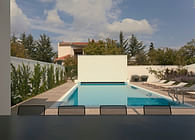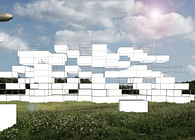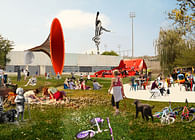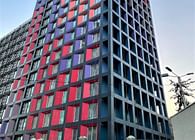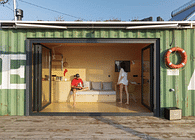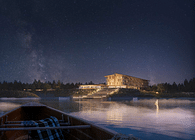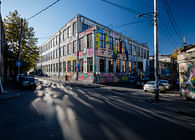
Tbilisi, GE
The site is located on the northern part of the Black Sea coast. Lazika is a newly founded city in the region Samegrelo-zemo svaneti. Lazika lies near the site of the ancient Greek colony of Phasis (Poti) and Anaklia city. The name 'Lazika' refers to the Graeco-Roman name for the region. The city’s existence was announced in December, 2011 by President Saakashvili, and established upon the completion of the Lazika municipality building in September 2012. The city lies at an altitude of two meters above sea level. The region has high level of humidity and dump soil, so local peoples traditionally built houses on stilts with no foundation to encourage ventilation from underneath and keep the structure dry.
The Idea of this project was to make a building as a sculpture made out of one material. Building is seen a series of floating objects. The suspended volumes create public spaces, separated from each other, forming a monument, and saliently, a benchmark for the new architecture of new futuristic city. Each volume of the building can function separately from the other. The local architecture was historically stilt-supported so there is natural precedent here. Also Yona Friedman’s ‘floating city’ was the main correlation point for this project. Flat geography helps a floating space to have 360-degree views towards the square and the city.
A specific appearance was given to each functional volume the transparent (public hall), the semi-transparent (wedding hall), and the translucent (offices). The public hall has clear walls on all four sides. The wedding hall is a dynamic volume where floor, wall and ceiling utilizes the same material and the curve brings dynamics to the adjacent terrace which lies underneath the top volume. The top volume is an enclosed mass, concentrated on the activity of office work, but it too, gives precedence to the void at its center.
Steel structured Building was a collaboration with engineers Engenuiti. The brief was to create a Public Service Hall, a Wedding Hall and Municipal Offices for about 40 employees. Work on the project began at the end of January, 2012, and the building was completed in mid-September, 2012. The building was constructed in 168 days with a progressive drafting schedule.
The foundation solution was for 80 piles 800mm diameter (has been installed through rotary percussion methods) and up to 25m deep. Control of settlements due to organic layers and control of potential liquefaction of the ground during a seismic event were the main concerns. Steel-frame construction was 30% quicker than concrete and less labor involved.
Paul Grimes, director of Engenuiti, describes the structure: ‘The structural frame is constructed from steel, utilizing a series of raking steel columns to produce the dramatic floated upper platform. Challenges include the seismic conditions and the sympathetic employment of local skills to achieve what will be an iconic statement of architectural ambition’.
The three volumes of this structure are all detached from the ground at different levels. Each of these three shapes are devoted to different function, they have their own entrance from the street but they are also interconnected. The volume on the ground level is designated as the main Public Services Hall, with easy access at street level. The second volume is dedicated for use as a wedding ceremony hall with direct access to a large terrace. The third volume has the dimensions of 35mx35m, it floats 20m above the ground and contains office spaces. The perforated steel sheet cladding finishing of the facade of the top volume bring 50% transparency. Only pillars and circulation points touch the ground. The steel frame structure is integrated throughout all parts of the design and this frame is exposed to emphasize the building's technology and spirit of innovation.
Status: Built
Location: Lazika, Georgia
